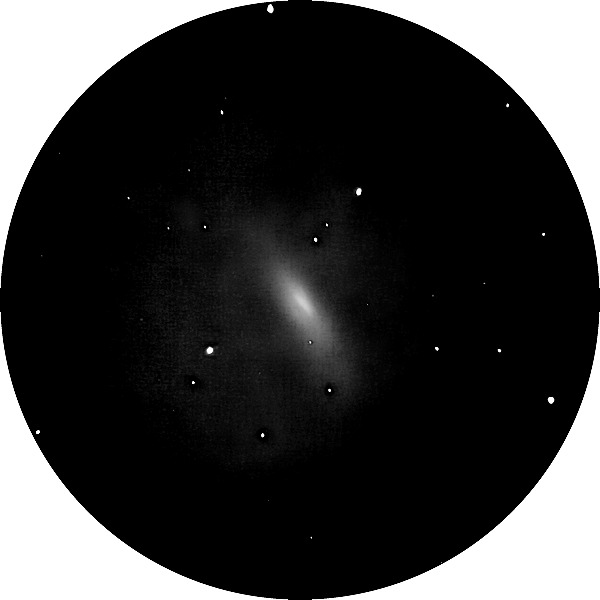iPhone Astrophotography: Orion Nebula, Star Trails,
Galaxies, Leo Triplet
Posted: 25 February 2020
Clouds from an approaching storm system arrived on Thursday, 20 February 2020. Rain began on Saturday, 22 February, with a total of 0.65" that day. Another 0.02" of rain fell on Sunday, 23 February. The sky cleared on Monday, 24 February.
|
Open: Monday, 24 February 2020, 1806 MST Temperature: 66°F |
Session: 1443 Conditions: Clear, breezy |
Equipment:
12" f/8 LX600 w/StarLock
2" 24mm UWA eyepiece
2" 30mm eyepiece
2" 50mm eyepiece
ETX-90AT
1.25" 26mm eyepiece
Camera:
D7200 DSLR
iPhone 11 Pro Max
First I set up the ETX-90AT on the observatory patio. I mounted the iPhone 11 Pro Max with a 8X telephoto lens piggyback on the ETX. I would use this setup for imaging the Orion Nebula later.

1833 MST: LX600 ON, StarLock OFF, High Precision OFF.
Viewed the planet Venus, 102X.
I noticed a thin crescent Moon very low in the western sky. Took these handheld photos with a D7200 DSLR.


1920 MST: the breezes had calmed down.
1930 MST: ETX-90AT ON.
Did a rough Polar Alignment of the ETX. I then began taking piggybacked photos of the Orion Nebula (M42) with the iPhone 11 Pro Max using the iOS app NightCap Camera (Long Exposure, Light Boost, 1sec, 1 minute exposure). The constellation of Orion is at the center of the first three photos.
0.5X lens, ISO 8064

1X lens, ISO 12500

2X lens, ISO 8064

1X lens + 8X telephoto lens, ISO 12500

I removed the iPhone from the piggyback position. Viewed M42 (Orion Nebula), 48X. Then mounted the iPhone on the eyepiece using the Levenhuk adapter.

The iOS Camera app in "Night Mode" was used for this afocal 48X, 30 seconds exposure.

2035 MST: ETX-90AT OFF.
2050-2101 MST: took a short break to warm up.
When I returned I set up the iPhone 11 Pro Max on a camera tripod. Took this 1 hour long Star Trails image with NightCap Camera (Star Trails, Light Boost, ISO 12288, 1X lens). There are also many trails from planes and two short satellite trails. I saw a "head-on" meteor and it was captured at about 8 o'clock from Polaris. The dome of the observatory is at the bottom.

This short exposure (1 minute) shows the stars untrailed. The constellation of Cassiopeia is at the left.

2215 MST: ended sky imaging.
Returned to the 12" telescope. Viewed M95 (galaxy), 81X.
Mounted the iPhone on the 30mm eyepiece with the Levenhuk adapter.
2225 MST: StarLock ON.
Did StarLock autoguided afocal 81X imaging of some galaxies for my iPhone Messier Catalog Album. Exposures were done with NightCap Camera (Long Exposure, Light Boost, ISO 12500, 1sec, 1 minute, 1X lens).
M95

M96

M65

M66

I also imaged NGC3628 (Sarah's Galaxy), StarLock autoguided, afocal 81X, NightCap Camera (Long Exposure, Light Boost, ISO 12500, 1sec, 1 minute, 1X lens).
NGC3628 (Sarah's Galaxy)

I switched to a 50mm eyepiece for this StarLock autoguided, afocal 49X, NightCap Camera (Long Exposure, Light Boost, ISO 12500, 1sec, 1 minute, 1X lens) image of the Leo Triplet (M65, M66, NGC3628).
Leo Triplet (M65, M66, NGC3628)

2245 MST: StarLock OFF.
Viewed NGC3628 (Sarah's Galaxy), 81X. Then M66 (galaxy), 81X. Then viewed the Leo Triplet, 102X. I tried to see the recent Supernova 2020cwh in M66, but didn't see it. (The iPhone image of M66 didn't capture it either.)
2309 MST: LX600 OFF.
2316 MST: took a SQM reading with the Unihedron SQM-L.
|
Close: Monday, 24 February 2020, 2320 MST Temperature: 45°F |
Session Length: 5h 14m Conditions: Clear, SQM 21.32 |
Comments are welcome using Email. Twitter users can use the button below to tweet this report to their followers. Thanks.
Cassiopeia Observatory Home Page
Copyright ©2020 Michael L. Weasner / mweasner@me.com
URL = http://www.weasner.com/co/Reports/2020/02/25/index.html
